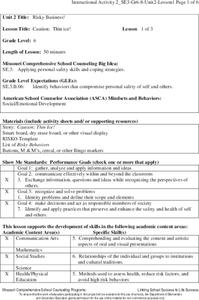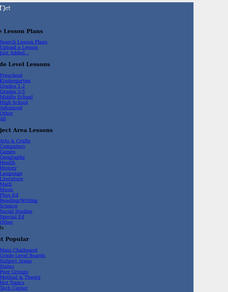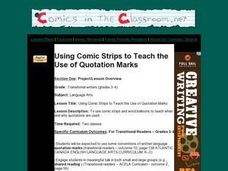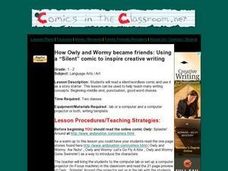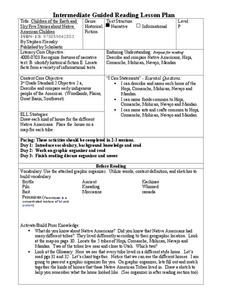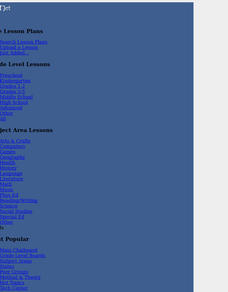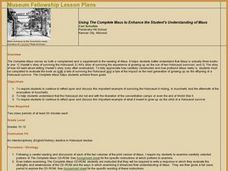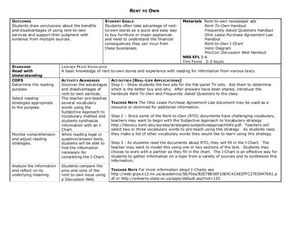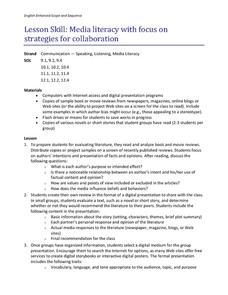Curated OER
Paradise Lost: Bloom’s Taxonomy of Thinking Processes
Chapter II of John Milton's Paradise Lost provides the text for a series of comprehension questions crafted using Bloom's Taxonomy.
Channel Islands Film
Arlington Springs Man: Lesson Plan 2
West of the West's documentary Arlington Springs Man and a two-page scientific article about the same topic provide the text for a reading comprehension exercise that asks individuals to craft a one page summary of information gathered...
Roald Dahl
Matilda - The Platinum-Blond Man
Before reading Chapter Six, "The Platinum-Blond Man" in Matilda, readers preview the illustration of Mrs. Wormwood dropping her plate of food, and think about what may have happened to cause the scene. After reading the chapter, class...
Missouri Department of Elementary
Goldilocks Revisited
After a read-aloud of the story Goldielocks and the Three Bears, scholars gather into small groups to answer a series of questions. Peers examine the idea of smart decisions and identify three feelings of characters alongside three...
Missouri Department of Elementary
Caution: Thin Ice!
Sixth graders listen to a story titled "Thin Ice!" then partake in a whole-class discussion asking and answering questions about what was read. Scholars brainstorm risky behaviors in preparation for a game of RISKO—a game similar to...
Curated OER
Meeting and Reading Dr. Seuss
Second graders demonstrate competence in the general skills and strategies of the reading process.
Curated OER
Responding to Open-Ended Questions using RASP
Students learn how to answer questions correctly. In this writing lesson, students learn the acronym RASP and view model responses for each part of the writing strategy. Students practice using the RASP model to answer...
Curated OER
Read Aloud- Literary Elements- Prediction
First graders read two stories. In this literary elements lesson, 1st graders read The Hat by Jan Brett, notice patterns of prediction, identify the setting, problem and solution and compare the story to the book The Mitten.
Curated OER
Using Comic Strips to Teach the Use of Quotation Marks
Students identify when and why quotations are used. Using comic strips and speech bubbles, they read and discuss examples of quotation marks, and in pairs write text for a cartoon on a piece of paper using quotation marks around the...
Curated OER
How Owly And Wormy Became Friends: Using a Silent Comic To Inspire Creative Writing
Learners view a wordless comic before using it as a story starter. They access a story that uses the same characters at a website in order to better understand the nature of the characters. They write a story inspired by the comic and...
Curated OER
Intermediate Guided Reading Lesson Plan
Third graders read Children of the Earth and Sky: Five Stories about Native American Children by Stephen Krensky. In this guided reading instructional activity, 3rd graders gain knowledge about various Native American tribes. Using a...
Curated OER
Awesome authors (Elementary, Reading/Writing)
Fifth graders use technology to research and collect data. They develop awareness and appreciation of authors and genres. They organize information for presentation.
Curated OER
Dinosaurs---Read All About Them!
Students read all about dinosaurs. In this biology lesson plan, students examine how to use library research as integral part of scientific research.
Curated OER
Sticks, Stones, Sinews and Stuff: How Early People Used the Environment to Meet Basic Needs
Students create an artifact. In this early survival lesson, students use found objects to create an artifact that could have been used to help early people meet their basic needs.
Curated OER
Using The Complete Maus to Enhance the Student's Understanding of Maus
Students read The Complete Maus to explore how Maus is actually three books in one. In groups, they evaluate the book as a tale of surviving the Holocaust and a tale of impacting future generations. They examine the conditions at...
Curated OER
The Difference Between Acids and Bases Using Different Indicators
Students identify the differences between acids and bases. In this acids and bases lesson plan, students identify and distinguish between acids and bases. They use household products to test the ph levels. They test the ph levels by...
Curated OER
Using Dialogue Journals in Support of Science Instruction
Students build a dialog journal within their science class. They develop written responses to questions asked by the teacher in a journal notebook. Teachers have the responsibility to read and respond to student responses.
Curated OER
Using Old Maps as Tools to Explore Our World
Young scholars explore historical maps. In this primary source analysis instructional activity, students uncover the meanings in selected historical maps as they use them to enhance lessons on historical events. Samples for classroom use...
Curated OER
Using Team Games Tournaments
Students review the unit on evolution and natural selection by playing a card game. Students take turns drawing a card from the stack and reading the question out aloud. The reader gives an answer. The other students, in turn may pass or...
Brigham Young University
K-W-H-L for Harry Potter and the Chamber of Secrets
To prepare for a study of Harry Potter and the Chamber of Secrets, the second in the series of seven books about J.K. Rowling's amazing young wizard, readers complete a K-W-H-L chart.
Curated OER
Rent To Own
Reading can be a good way to learn about many different things, like rent-to-own housing programs. Learners read informational resources about rent-to-own programs and how they work. They complete graphic organizers using the facts they...
Curated OER
Much Ado About Nothing: Guided Imagery Exercise
“Be glad that all things sort so well.” To make text-to-self connections to Shakespeare’s play, class members engage in a guided imagery exercise prior to reading Act IV, scene i of Much Ado About Nothing (the wedding of Claudio and...
English Enhanced Scope and Sequence
Media Literacy with Focus of Strategies for Collaboration
Introduce your class to literary analysis with a series of activities that has them examine book and movie reviews. Groups then draft their own review of a text, select a digital medium, and craft a presentation.
Novelinks
Count of Monte Cristo: Professor Know‐It‐All
Kids love to be the experts! With four themes from The Count of Monte Cristo by Alexandre Dumas, small groups work together to answer specific questions addressing each theme. They then stand in front of the class and field...




